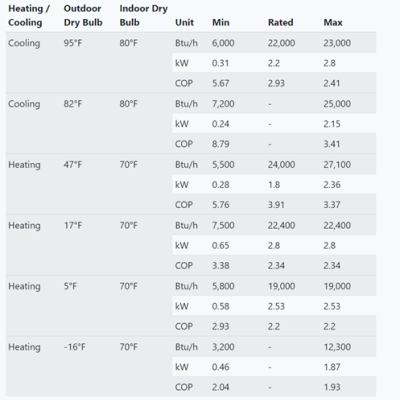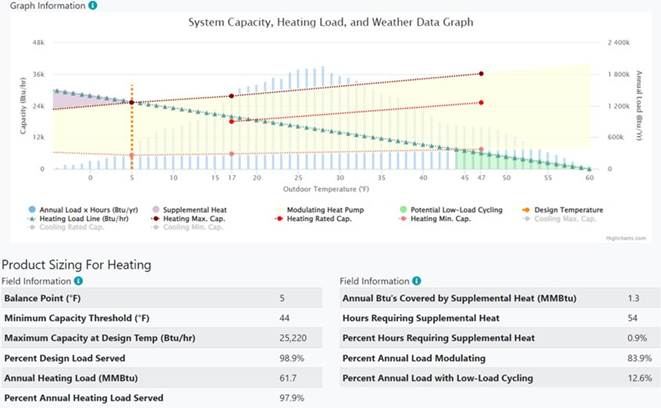

By David Lis | Mon, December 11, 23
The landscape around heat pump performance specifications and data has evolved in recent years and in the process has raised new questions as to where specifications and performance reporting for heat pumps should go in the future. Let’s break down where we’ve been and look at where and how we can forge new frontiers.
NEEP’s regional market transformation initiative for heat pumps was launched in 2013. During the past eight years, propelled in part by market supporting tools and resources, sales of heat pumps in the Northeast have increased by 20-30 percent annually!
In 2015, NEEP launched its Cold Climate Air-source Heat Pump Specification and associated Product List in response to two glaring needs in the emerging cold climate heat pump market: (1) The lack of technical criteria to differentiate heat pump systems for cold climate applications and (2) the lack of realistic heat pump performance data across a wide range of operating conditions to inform effective sizing/selection decisions. Since that time, the specification and product list have primarily been used in two ways: (1) As a qualified products list (QPL) for “cold climate” ASHPs, and (2) as a performance data resource for heat pump sizing/selection.
Between 2017 and 2022, NEEP led robust stakeholder engagement that informed three revisions to the specifications and the launch of a new sizing tool. The tool leverages the extended performance data (see chart 1 above) for more effective product sizing and selection. In each case, the specification and product list have pushed industry boundaries beyond what had been previously available in the market.
New National Efforts Set Cold Climate Specifications
With the introduction of U.S. Department of Energy (DOE)’s Cold Climate Heat pump technology challenge specification, ENERGY STAR’s cold climate criteria and the Consortium for Energy Efficiency’s (CEE) “North/Canada” tiers, cold climate heat pump specifications have gone “big time”. All these organizations are major players in the energy efficiency field, and each serves a unique aspect in setting high performance specifications. While DOE’s challenge specification is meant to push the bounds of cold climate performance, ENERGY STAR and CEE are focused on recognizing today’s market leaders. The ENERGY STAR and CEE specifications are nearly identical but have some unique components. For instance, ENERGY STAR uses a verification process for performance at 5° Fahrenheit (F). DOE’s cold climate challenge specification requires performance reporting at -5°F or -15°F and includes partial load tests at 47°F.
The Inflation Reduction Act (IRA)’s heat pump incentive programs specify the use of ENERGY STAR and CEE specifications for various tax credits and rebates, which will likely increase significantly market recognition of these two specifications.
NEEP, and the region, can take credit for informing these national specifications. While these specifications have in some ways taken the NEEP specification to a new level, the extended performance data collected and made available by NEEP is still a critical area not addressed in the national specifications.
Extended Performance Data Enables Effective Product Selection
Performance data across a broad range of temperature points is necessary to effectively size and select heat pumps for cold climate applications, especially when designing a whole home heat pump system responsible for doing all the heating and cooling in the home. Stakeholder feedback led NEEP to develop new visuals to make the data more informative and actionable.
Today, the data is being used in a few key ways. Designers and contractors (and some homeowners) use NEEP’s sizing tool (see chart 2 above) to ensure systems can deliver the necessary heat at different temperature points, while avoiding oversizing/cycling for more moderate temperatures. Program administrators have leveraged the data and tool to support contractor training and to develop third-party consumer facing tools to help drive informed decisions.
Uses for the NEEP data continue to evolve and influence other industry tools. Modeling organizations - including those that may impact building energy code compliance - are examining the extended performance data found in the NEEP product list as the source of data to drive their models. As part of the recent industry shift to new efficiency metrics (HSPF/SEER to HSPF2/SEER2) for heat pumps, Air Conditioning, Heating and Refrigeration Institute (AHRI) added reporting fields to their Directory of Certified Product Performance. New reporting fields include capacity and efficiency at 5F. Air Conditioning Contractors of America (ACCA) has been a leading industry actor on protocols for proper sizing/selection of air conditioners and heat pumps. In fact, The American National Standards Institute (ANSI) recently issued approval of proposed revisions to ANSI/ACCA Manual S® - 2014, Residential Equipment Selection. The approved standard will be designated as the 2023 edition, and it will incorporate new guidance on sizing/selecting heat pumps for cold climate applications, which will guide installers to utilize extended performance data in new ways.
As performance data has become more available, it has faced increased scrutiny over its accuracy. Many key pieces of performance data found in the NEEP product list are manufacturer-reported without industry standards for determining appropriate values. While the extended performance data aims to bring transparency about heat pump performance to these various use cases, there is growing interest in driving more standardization into the industry for how these values are determined.
Heat Pump Test Procedures Drive Market Consistency
This brings us to test procedures for heat pump performance. Residential heat pump performance has long been derived by AHRI’s 210/240 test method. The ability of this test procedure to accurately reflect true performance of variable speed heat pumps was one of the main drivers of the creation of NEEP’s ccASHP specification and reporting requirements and remains a central issue today.
The Canadian standards-setting body CSA led a multi-year process to develop a new “load based” test procedure for heat pumps. CSA SPE-07:23 offers a new way to assess heat pump performance under more realistic testing conditions.
US DOE recently opened a rulemaking to assess the current test procedure and determine if changes are necessary. As part of this process, DOE requested that AHRI lead a negotiated process to develop a proposal for new changes. That process looked at several issues related to variable speed systems and low temperature performance.
NEEP is also currently leading a project co-funded by eight separate organizations investigating the representativeness of the current AHRI 210/240 (Appendix M1) and SPE-07 test procedures. Those results are expected in Q1 2024 and will help inform future opportunities to improve heat pump test procedures.
Forging New Frontiers
Given the confluence of these policy and market activities, NEEP has launched a stakeholder-driven process to help guide NEEP and the industry more broadly on next directions with cold climate heat pump specifications and extended performance data.
NEEP kicked off this process in October at our annual Heating Electrification Workshop by gathering over 100 regional partners to begin the dialogue.
Here’s some of the initial feedback we received:
- During a time of emerging cold climate specifications/definitions, NEEP’s specification and product list has helped to provide market stability. There is growing interest in driving alignment of cold climate specifications.
- NEEP’s product list holds credibility in the market (among manufacturers, contractors, programs, consumers) in making additional performance data available, transparent, and useful. Additional performance data, beyond that made available by AHRI and manufacturers, is important to ensure quality design and installs and, ultimately, consumer satisfaction.
- Stakeholders support efforts to improve the quality/accuracy of additional performance data, as the data is critical to effectively designing ASHPs in cold climates.
- Stakeholders see opportunities to add new data fields and enhanced sizing tool functionality.
- Stakeholders support working with related heat pump industry actors (i.e., ACCA, AHRI) on alignment related to heat pump performance data and sizing guidance.
We look forward to shaping a shared vision with regional partners and ensuring the NEEP Product list evolves to meet the pressing needs of the market. What does the next frontier look like to you? If you would like to share ideas, reach out to Dave Lis.


